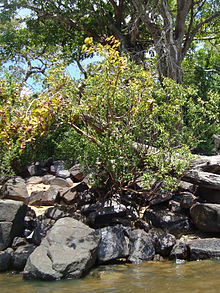| Myrciaria dubia | |
|---|---|

| |
| Scientific classification | |
| Kingdom: | Plantae |
| Clade: | Tracheophytes |
| Clade: | Angiosperms |
| Clade: | Eudicots |
| Clade: | Rosids |
| Order: | Myrtales |
| Family: | Myrtaceae |
| Genus: | Myrciaria |
| Species: | M. dubia
|
| Binomial name | |
| Myrciaria dubia (Kunth) McVaugh
| |
| Synonyms[2] | |
| |

Myrciaria dubia, commonly known as camu-camu, caçari, araçá-d'água, or camocamo, is a species of plant in the family Myrtaceae. It is a small bushy riverside tree from the Amazon rainforest in Peru and Brazil, which grows to a height of 3–5 m (9.8–16.4 ft) and bears a red/purple cherry-like fruit. It is a close relative of the false jaboticaba (Myrciaria vexator) and the guavaberry or rumberry (Myrciaria floribunda). As much as 2 to 3% of the fresh fruit by weight is vitamin C.
- ^ IUCN SSC Global Tree Specialist Group, Botanic Gardens Conservation International (BGCI); Canteiro, C. (2019). "Myrciaria dubia". IUCN Red List of Threatened Species. 2019: e.T152941355A152941357. doi:10.2305/IUCN.UK.2019-3.RLTS.T152941355A152941357.en. Retrieved 12 December 2022.
- ^ "Myrciaria dubia (Kunth) McVaugh". The Plant List: A Working List of All Plant Species. Retrieved 16 January 2021.
